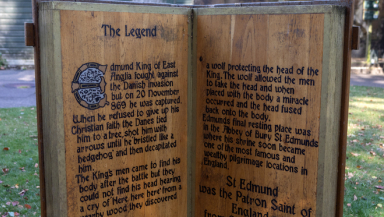
20 November is St Edmund’s Day, celebrating the king and martyr who was once the patron saint of England. This is his story.
East Anglia
Before England was unified in the tenth century, it was a patchwork of kingdoms belonging to the Anglo-Saxon tribes. The eastern Angles formed the Kingdom of East Anglia, which included the regions of Norfolk (the North Folk) and Suffolk (the South Folk). The early royal burial ground of the East Anglian kings was excavated at Sutton Hoo near Woodbridge in Suffolk. Today, the region is still known as East Anglia.
King Edmund
Edmund (also spelt Eadmund) was born in East Anglia in or about the year 840, probably the son of King Athelweard. He succeeded to the throne of East Anglia in 854 after the death of his father. Edmund was only a teenager when he was crowned on Christmas Day 854 by Humbert, Bishop of Elmham.
Martyr
King Edmund was a Christian who had learnt the Psalms by heart. In 869 he fought alongside King Alfred of Wessex against the Viking and Norse invaders, referred to in the Anglo-Saxon Chronicle as the “Great Heathen Army.”
When his forces were defeated, Edmund was captured near Thetford by Ivar Ragnarsson, known as Ivar the Boneless. Edmund was ordered to renounce his faith and share power with the pagan Vikings, but he refused.
He was killed by the Danes on 20 November 869 after refusing to renounce Christianity. According to the story, after being tied to a tree and shot full of arrows, he was then beheaded.
According to Abbo of Fleury, Edmund died at Haegelisdun. Early tradition places this at Hoxne near Eye in Suffolk. He was then buried in a wooden chapel nearby.
Successors
Edmund was succeeded as king of East Anglia by Oswald, then Athelstan, and then Ethelred II. Then, in 878, East Anglia was awarded to Guthrum, the Danish king who was baptised by King Alfred. Guthrum ruled under the name King Athelstan. After King Athelstan’s death in or near 890, East Anglian coin-makers minted commemorative pennies of Edmund with the words Sce Eadmvnd Rex (“O St Edmund the King”), which were widely used in the Danelaw. This shows that he was already considered a saint.
Anglo-Saxon Chronicle
What we know about Edmund comes from the Anglo-Saxon Chronicle and from the later writings of a French monk called Abbo of Fleury. According to Abbo, his source was St Dunstan, Archbishop of Canterbury, who had heard the story from an old man who had been Edmund’s sword-bearer.
Bury St Edmunds
In 902, Edmund’s remains were moved to Beodericsworth on the River Lark in Suffolk. In 925, King Athelstan of England founded a religious community to care for Edmund’s shrine. After King Canute became a Christian, he ordered a new stone abbey to be built over the site, which was completed in 1032. The Abbey of St Edmund became one of England’s major pilgrimage sites. Pilgrims came from all over Europe, and the town is known to this day as Bury St Edmunds.
Edmund’s shrine was destroyed in 1539 during the dissolution of the monasteries, and knowledge of its exact location was slowly lost, though there is renewed interest in rediscovering it. Since 1914, the abbey has been the cathedral of the Anglican Diocese of St Edmundsbury and Ipswich, which covers most of Suffolk.
St Edmund
Edmund the Martyr was never formally canonised, but he was widely venerated as a saint after his death. He is considered the patron saint of kings, victims of plague and pandemics, and was formerly the patron saint of England.
There are about thirty Anglican and Catholic churches dedicated to St Edmund in England, mainly in the east and Midlands, such as St Edmund’s in Southwold, Suffolk, and St Edmund’s in Acle, Norfolk. The most well known is probably St Edmund the King and Martyr’s Church in Lombard Street, London. There are also churches dedicated to him in Australia, Canada, the USA, and in San Bernardo, Chile (San Edmundo Rey y Mártir). St Edmund is depicted in many stained glass windows.
Former Patron Saint of England
England had several saints who were considered patron saints, but St Edmund was the main one, along with Edward the Confessor. The banner of St Edmund was carried into battle by the English army in medieval times. However, by the time of King Edward I, at the end of the thirteenth century, his banner had been joined by the red cross banner of St George. In the fourteenth century, St George replaced St Edmund as patron saint of England. St Edmund’s banner is now used as the flag of the county of Suffolk.
Memorials
The ancient oak tree at Hoxne, traditionally believed to be the place where St Edmund was slain, was respected for centuries and grew into a massive, hollow oak. It finally fell in the summer of 1848 under its own weight. A monument was erected on the spot, which collapsed in a storm in 1905 and was replaced by the current monument. It reads: “Saint Edmund the Martyr AD 870.” Since 2017 it has been a Grade II listed monument.
Today there is a pilgrimage route called the St Edmund Way, an 80-mile route from Manningtree in Essex to Brandon in Suffolk via Bury St Edmunds.
St Edmund’s Day
St Edmund’s Day is on 20 November, the date of his martyrdom. St Edmund the King and Martyr is a saint of the Catholic Church and remembered with a lesser festival in the Church of England.
Collect
The Anglican collect prayer for St Edmund’s Day is:
“Eternal God, whose servant Edmund kept faith to the end, both with you and with his people, and glorified you by his death: grant us such steadfastness of faith that, with the noble army of martyrs, we may come to enjoy the fullness of the resurrection life; through Jesus Christ your Son our Lord, who is alive and reigns with you, in the unity of the Holy Spirit, one God, now and for ever. Amen.”













